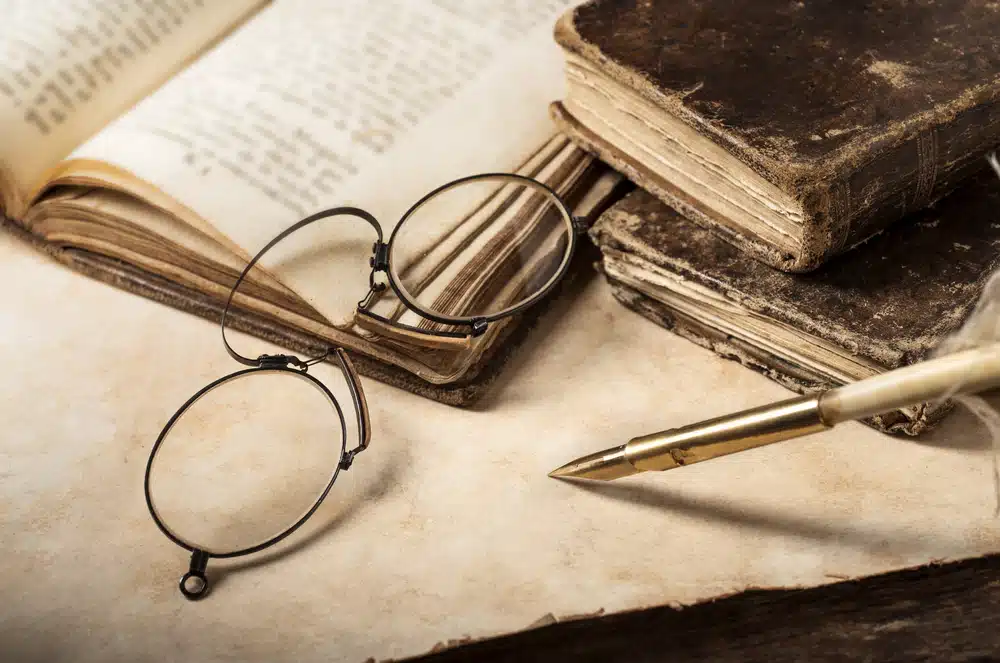Eyeglasses as we know them today are a regular part of daily life. Most of us probably don’t stop to think about their history and how far they’ve come as vision aids. So, we put together a timeline outlining their significant development stages in history.
Contents
1000 AD
It’s believed that the first invention designed to aid vision was the reading stone, which became widely used in 1000 AD. Generally, these stones were made of rock crystal, like quartz or glass. People would place the stone over the text and glide it as they read. It would work much like a magnifying glass.
13th Century
The first wearable eyeglasses were invented in Italy in the late 13th century, although the actual identity of the inventor is unknown. Initially, these glasses were worn by scholars and monks. They had no temples (side pieces) and were simply held in front of the eyes or balanced on the nose. The glasses themselves were framed in leather, and this style was worn until 1452, when the production of books and the increase in literate citizens demanded new designs and mass production.
This was also the century when scientists began experimenting with convex lenses—which are what we use for farsightedness today.
15th Century
Concave lenses came after convex lenses and were invented to correct nearsightedness. Generally, this lens is thought to have been invented by Nicholas Krebs, a Cardinal of the Roman Catholic Church. By the 17th century, people began understanding the science behind concave and convex lenses and became more widely used to correct vision issues related to distance.
The 1700s
The next point of extensive development for eyeglasses occurred in the 1700s. In this century, eyeglasses included temples to secure the frames over the ears. They were also made by hand.
Common Styles
- Wig Spectacles: This particular style of glasses was characterized by the long temple pieces that extended over the ears. They were called wig spectacles because they had a loop on the temple ends to be inserted into a wig. These glasses were popular among men of higher classes—some wore them as a symbol of status rather than out of necessity.
- Bifocals: Still a common type today. The bifocal was invented in 1784 by Benjamin Franklin. They include a lens that can accommodate both short and long vision.
The 1800s
During the 1800s, the manufacturing of eyeglasses took on a much larger scale, and people were able to purchase them for reasonable prices from many shops and merchants.
Common Styles
- Lorgnette: In the 1800s, there was a societal view that wearing glasses was a sign of ill health and old age. For this reason, people wanted to avoid wearing glasses. The Lorgnette was a clever compromise. The design featured a pair of glasses but with one long handle instead of temples.
- Quizzing Glasses: These compact, oval-shaped glasses were characterized by their miniature lenses, delicate frames, and a single handle. Quizzing spectacles were not just a practical solution for vision correction but also a fashion statement. Their elegant designs made them a symbol of sophistication and charm for both men and women of the era.
The 1900s
During the 1900s, the manufacturing of eyeglasses became a booming industry in itself. The range of styles available became extensive as Hollywood expanded and celebrities began to influence the fashions of the time.
Common Styles
- Pince-Nez: This style was popular during 1900-1920. It was a French style featuring a small frame that fits snugly over the face and pinched the nose. It usually didn’t come with any temple arms or handles.
- Round Lenses: Thanks to the Hollywood actor Harold Lloyd, the Pince-Nez was mercilessly thrown out of favour in the late 1920s. The style was replaced by a large round lens inside a tortoiseshell frame.
- The Upsweep: In the 1940s, the frame of the moment featured an upsweep on the top rim, simulating the sweep of a woman’s eyelashes. The frames themselves became available in a variety of colours.
21st Century
Since the 1950s, the styles and types of eyeglasses available have become numerous—and fashion changes by the year rather than the decade. In the 21st century, eyeglasses are a fashion statement as much as a practical necessity and countless designers have turned their talents to creating the styles of the moment. Here are some of the popular styles of the modern day:
- Wayfarer Glasses: Characterized by their bold, square-shaped frames. Wayfarer glasses often feature thick frames that come in various colours and patterns. These frames offer a classic, retro-inspired look that appeals to individuals seeking a balance between vintage and contemporary fashion.
- Rimless/Semi-Rimless Glasses: These glasses are minimalist by design. These frames are incredibly lightweight and discreet, as they lack a traditional frame around the lenses. The temples are often attached directly to the lenses, giving them the impression of the glasses floating on the wearer’s face. Rimless and semi-rimless styles provide a clean and modern aesthetic, allowing the focus to remain on the eyes.
- Cat-Eye Glasses: Cat-eye glasses are known for their unswept outer corners, which create a feline-inspired, retro look. The frames come in various materials and colours, but they always maintain this distinctive shape.
Find Your Style at Laurier Optical
At Laurier Optical, we’re proud to offer a wide range of styles and designer glasses at accessible prices. Whether you want a vintage or modern look, we have an option for you to express your individuality. Visit us today to explore your choices.
